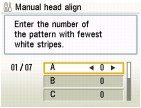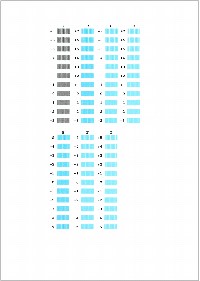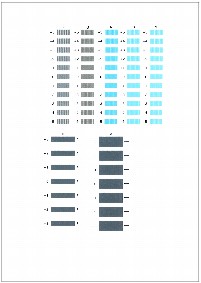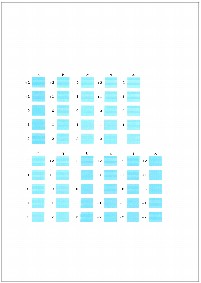Aligning the Print Head |
 |
If ruled lines are printed with misaligned or print results are otherwise unsatisfactory, adjust the print head position.
 Note: Note:
Make sure that the Inner Cover is closed.
|
 Automatic Print Head Alignment
Automatic Print Head Alignment
 Important Important
You cannot feed paper from the Cassette when performing Automatic Print Head Alignment. Always load paper in the Rear Tray.
|
1. Make sure that the machine is turned on, and then load two sheets of supplied paper or A4/Letter-sized Canon Matte Photo Paper MP-101 with the printing side (whiter side) facing up.
2. Open the Paper Output Tray, and then open the Output Tray Extension.
(1) Put your finger in the rounded indent of the Paper Output Tray and open it gently.
(2) Open the Output Tray Extension.
3. Adjust the print head position.
(1) Press the HOME button.
The HOME screen is displayed.
(2) Select Settings  , then press the OK button.
, then press the OK button.
The Settings screen is displayed.
(3) Select Maintenance, then press the OK button.
The Maintenance screen is displayed.
(4) Select Auto head align, then press the OK button.

The confirmation screen is displayed.
|  Note: Note:
If you select Head alignment print, the machine exits the process after printing the current head position adjustment values.
|
(5) Select Yes, then press the OK button.
The print head is aligned automatically, and the print head pattern after the adjustment is printed out. This takes about 10 minutes.
 Note: Note:
 The print head alignment pattern is printed in black and blue. The print head alignment pattern is printed in black and blue.
 If adjustment was not done successfully, the "Auto head align has failed." error message is displayed on the LCD. If adjustment was not done successfully, the "Auto head align has failed." error message is displayed on the LCD.
 If results of Automatic Print Head Alignment are not satisfactory, perform Manual Print Head Alignment. For details, see Manual Print Head Alignment. If results of Automatic Print Head Alignment are not satisfactory, perform Manual Print Head Alignment. For details, see Manual Print Head Alignment.
|
 Manual Print Head Alignment
Manual Print Head Alignment
If the results of Automatic Print Head Alignment are not satisfactory, follow the procedure below to perform Manual Print Head Alignment.
For details on performing Automatic Print Head Alignment, see Automatic Print Head Alignment.
 Note: Note:
Screens and Manual Print Head Alignment patterns may differ from those shown in this section.
|
1. Make sure that the machine is turned on, and then load four sheets of A4 or Letter-sized plain paper in the Rear Tray or Cassette.
2. Open the Paper Output Tray, and then open the Output Tray Extension.
(1) Put your finger in the rounded indent of the Paper Output Tray and open it gently.
(2) Open the Output Tray Extension.
3. Press the Paper Feed Switch to select the paper source where you have loaded paper.
4. Print the print head alignment pattern.
(1) Press the HOME button.
The HOME screen is displayed.
(2) Select Settings  , then press the OK button.
, then press the OK button.
The Settings screen is displayed.
(3) Select Maintenance, then press the OK button.
The Maintenance screen is displayed.
(4) Select Manual head align, then press the OK button.
The confirmation screen is displayed.
 Note: Note:
If you select Head alignment print, the machine exits the process after printing the current head position adjustment values.
|
(5) Select Yes, then press the OK button.
The print head alignment pattern is printed.
(6) When "Did the patterns print correctly?" is displayed, confirm that the pattern is printed correctly, select Yes, then press the OK button.
The input screen for the head position adjustment values is displayed.

5. Look at the first printout, and then adjust the print head position.
(1) Check the printed patterns and use the  or
or  button to input the number of the pattern in column A that has the least noticeable vertical streaks.
button to input the number of the pattern in column A that has the least noticeable vertical streaks.

|  Note: Note:
If it is difficult to pick the most even pattern, pick the setting that produces the least noticeable vertical white streaks.
|

(A) Less noticeable vertical white streaks
(B) More noticeable vertical white streaks
(2) Repeat the same procedure until you finish inputting the pattern number for columns B to G, then press the OK button.
(3) Confirm the displayed message and press the OK button.
The second pattern is printed.
6. Look at the second printout, and then adjust the print head position.
(1) Check the printed patterns and use the  or
or  button to input the number of the pattern in column H that has the least noticeable vertical streaks.
button to input the number of the pattern in column H that has the least noticeable vertical streaks.

(2) Repeat the same procedure until you finish inputting the pattern number for columns I to O, then press the OK button.
(3) Confirm the displayed message and press the OK button.
The third pattern is printed.
7. Look at the third printout, and then adjust the print head position.
(1) Check the printed patterns and use the  or
or  button to input the number of the pattern in column P that has the least noticeable vertical streaks.
button to input the number of the pattern in column P that has the least noticeable vertical streaks.

(2) Repeat the same procedure until you finish inputting the pattern number for columns Q to V, then press the OK button.
For columns U and V, the best patterns will be smooth and have no streaks in the border indicated by the arrows.
|  Note: Note:
If it is difficult to pick the most even pattern, pick the setting that produces the least noticeable horizontal white streaks.
|

(C) Less noticeable horizontal white streaks
(D) More noticeable horizontal white streaks
(3) Confirm the displayed message and press the OK button.
The fourth pattern is printed.
8. Look at the fourth printout, and then adjust the print head position.
(1) Check the printed patterns and use the  or
or  button to input the number of the pattern in column a that has the least noticeable horizontal streaks.
button to input the number of the pattern in column a that has the least noticeable horizontal streaks.

|  Note: Note:
If it is difficult to pick the most even pattern, pick the setting that produces the least noticeable horizontal white streaks.
|

(E) Less noticeable horizontal white streaks
(F) More noticeable horizontal white streaks
(2) Repeat the same procedure until you finish inputting the pattern number for columns b to k, then press the OK button.